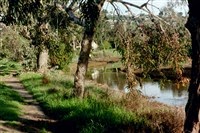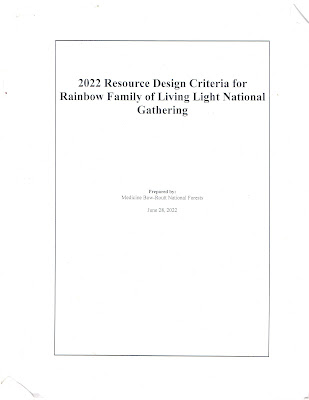Sustenance and Safety (Part 3 of 5 of "Creating Peace")
One of the foundations of creating peace is making sure people are prepared, in the right mindset, and able to do the hard work that creating peace entails. Sustenance and Safety are the building blocks of peace.
Sustenance takes care of our bodily needs. We can't think well when our blood sugar is crashing or when we are dehydrated. Adequate food and water is a must for all in order to be able to even discuss peace (stay tuned for part 4 of Creating Peace).
One of the most important actions a person can take at a gathering is making sure everyone is eating and drinking plenty of water. This year we will be in the midwest and that generally means moister gatherings and lot's of sweating. One gallon a day of water that has been boiled for 20 minutes or filtered with a 0.2 micron or smaller filter is a must.
When people haven't eaten or are dehydrated they act out. When they are in these conditions for too long, they get sick. When you combine these issues with over-indulgences, we have a recipe for problems that can impact the entire gathering.
Prevent the problems by making sure you and the people in your vicinity are eating and staying hydrated. Be on the look out for people who look like they aren't getting food and/or water and help them before they start breaking the peace.
Now for the tough topic: safety.
Safety is a bit harder to come by because what constitutes a feeling of safety is a very subjective and emotional feeling. To explain what I mean, we'll talk about the estuary by my house. The salt marsh and estuary have been channelized to prevent flooding and on either bank is a trail. The east side is a paved path that hooks up with bike paths to the north and south. The west side is a dirt road with trees providing shade on a warm day as shown in the image.
People in my neighborhood have very different perspectives on the estuary. Some people view it as a haven for criminals and are afraid to go down there especially after dark. Other people loving taking their kids down to watch the Great Blue Herons and Osprey trying to rustle up a meal.
Now you would think there is some logic as to who feels safe at our estuary and who is scared, but so far I haven't observed any patterns. I see people with small kids down there watching the sunset and in the early morning many seniors walk their dogs. Then I meet other people in their thirties and forties who are scared to go down without a large group of people because once upon a time someone had a bike stolen (maybe 10 or 15 years ago).
In addition to the herons and hawks at the estuary, one finds the differentially housed: people who live in tents or throw down a sleeping bag under a bush for the night. Some people are scared of people with different lifestyles then their own, others exchange pleasantries with everyone. Some people who live in non-portable houses are scared of the differentially housed. Others make friends.
Every time I speak at a community meeting, some people go off the deep end on how dangerous the estuary is and others talk about how it's an asset to the community. I know that I can't change people's opinions about which is which. Plus trying to address how people feel is tough. Your feelings are neither right nor wrong, they just are.
Low crime rates do not make people feel safe. Community makes us feel safe.
So having said all this, how do we help everyone feel safe at the gathering?
One way we can do this is to treat others the way they would like to be treated -- not the way you would like to be treated. Try finding gentler voices. Look out for each other in peaceful ways and make sure the people in your vicinity seem comfortable. We all have different levels of tolerance, sensitivity, and fear. Honor that.
If someone looks uncomfortable, they probably are. Introduce yourself. Smile at someone you do not know. We all feel more comfortable when we are around friends. Share your gathering wisdom. Pay more attention to body language. Learn to pick up vibes from the people around you. If you sense that someone is afraid of a situation, help them to feel comfortable by either staying with them, removing both yourselves from the situation, or talking to the other person about their fears in a supportive way. Just because the situation is comfortable for you, doesn't mean it's comfortable for everyone.
Honor our differences and our need to be treated accordingly. Help each other on this journey.
Please pay special attention to law enforcement officers. A scared cop is a dangerous cop (remember Wyoming 2008?). Turn down the volume on negative energy by oming instead of cussing when you do not like a situation.
Think about how you would like others to act around your three year-old child and your ninety year-old grandmother and act accordingly.
Read the rest of the series here.
Sustenance takes care of our bodily needs. We can't think well when our blood sugar is crashing or when we are dehydrated. Adequate food and water is a must for all in order to be able to even discuss peace (stay tuned for part 4 of Creating Peace).
One of the most important actions a person can take at a gathering is making sure everyone is eating and drinking plenty of water. This year we will be in the midwest and that generally means moister gatherings and lot's of sweating. One gallon a day of water that has been boiled for 20 minutes or filtered with a 0.2 micron or smaller filter is a must.
When people haven't eaten or are dehydrated they act out. When they are in these conditions for too long, they get sick. When you combine these issues with over-indulgences, we have a recipe for problems that can impact the entire gathering.
Prevent the problems by making sure you and the people in your vicinity are eating and staying hydrated. Be on the look out for people who look like they aren't getting food and/or water and help them before they start breaking the peace.
Now for the tough topic: safety.
Safety is a bit harder to come by because what constitutes a feeling of safety is a very subjective and emotional feeling. To explain what I mean, we'll talk about the estuary by my house. The salt marsh and estuary have been channelized to prevent flooding and on either bank is a trail. The east side is a paved path that hooks up with bike paths to the north and south. The west side is a dirt road with trees providing shade on a warm day as shown in the image.
 |
| The Estuary |
People in my neighborhood have very different perspectives on the estuary. Some people view it as a haven for criminals and are afraid to go down there especially after dark. Other people loving taking their kids down to watch the Great Blue Herons and Osprey trying to rustle up a meal.
Now you would think there is some logic as to who feels safe at our estuary and who is scared, but so far I haven't observed any patterns. I see people with small kids down there watching the sunset and in the early morning many seniors walk their dogs. Then I meet other people in their thirties and forties who are scared to go down without a large group of people because once upon a time someone had a bike stolen (maybe 10 or 15 years ago).
In addition to the herons and hawks at the estuary, one finds the differentially housed: people who live in tents or throw down a sleeping bag under a bush for the night. Some people are scared of people with different lifestyles then their own, others exchange pleasantries with everyone. Some people who live in non-portable houses are scared of the differentially housed. Others make friends.
Every time I speak at a community meeting, some people go off the deep end on how dangerous the estuary is and others talk about how it's an asset to the community. I know that I can't change people's opinions about which is which. Plus trying to address how people feel is tough. Your feelings are neither right nor wrong, they just are.
Low crime rates do not make people feel safe. Community makes us feel safe.
So having said all this, how do we help everyone feel safe at the gathering?
One way we can do this is to treat others the way they would like to be treated -- not the way you would like to be treated. Try finding gentler voices. Look out for each other in peaceful ways and make sure the people in your vicinity seem comfortable. We all have different levels of tolerance, sensitivity, and fear. Honor that.
If someone looks uncomfortable, they probably are. Introduce yourself. Smile at someone you do not know. We all feel more comfortable when we are around friends. Share your gathering wisdom. Pay more attention to body language. Learn to pick up vibes from the people around you. If you sense that someone is afraid of a situation, help them to feel comfortable by either staying with them, removing both yourselves from the situation, or talking to the other person about their fears in a supportive way. Just because the situation is comfortable for you, doesn't mean it's comfortable for everyone.
Honor our differences and our need to be treated accordingly. Help each other on this journey.
Please pay special attention to law enforcement officers. A scared cop is a dangerous cop (remember Wyoming 2008?). Turn down the volume on negative energy by oming instead of cussing when you do not like a situation.
Think about how you would like others to act around your three year-old child and your ninety year-old grandmother and act accordingly.
Read the rest of the series here.



Comments
Post a Comment
Racist, homophobic, and sexist comments will be removed as well comment advocating violence. Please share your perspective in a polite manner.